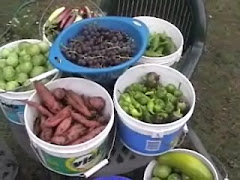
One of the more interesting plants we grow, or should I say, grows itself is strawberry spinach, also called strawberry blite, beet berry, Indian paint, and a number of other names. The plant is very cold hardy but will thrive in the hottest weather. With a long taproot it can get by on very little water, of course the more water it gets the larger the fruit.

Our strawberry spinach (Chenopodium capitatum) grows two-three feet in both height and width. The serrated triangular leaves are a great substitute for spinach when young but become somewhat tough as they mature. The mature plants develop brilliant red thimble sized berries that when really ripe taste, to me, just like Malt-O-Meal cereal... kind of sweet and nutty. How great is that, not only do you get to eat the greens but little fruit as well. Technically, I think the berry is considered a flower, I'm not really sure.

This plant can also be used to create pink and red dye by simmering the berries in water until the desired color is achieved, though I have never tried this. The seeds germinate rather sporadically but if allowed to reseed, and we allow it, they will come up on their own all over the garden. I have introduced this plant to the the wooded areas of our property and it seems to be taking hold, another great "permaculture" plant for the food forest.
I have no doubt that strawberry spinach has many healthy attributes, but do not know what they might be. I have read that they are possibly high in vitamin A and C. There seems to be very little information regarding this lesser known member of the goosefoot family. As always, I love plants that only need be planted once and then simply tended for many years thereafter.
















 As the maggots emerge they get in between the leaf tissue mining their way throughout the leaves as they feed.
As the maggots emerge they get in between the leaf tissue mining their way throughout the leaves as they feed. The first of the many cycles they go through each year seem to be the most damaging for our crops and as the season progresses the damage inflicted becomes less noticeable. The only solution I have come up with to combat these little nasties is to pull off the tunnelled leaves and feed them to our ravenous chickens.
The first of the many cycles they go through each year seem to be the most damaging for our crops and as the season progresses the damage inflicted becomes less noticeable. The only solution I have come up with to combat these little nasties is to pull off the tunnelled leaves and feed them to our ravenous chickens. On a smaller scale one could attempt to destroy the egg clusters before they hatch but we grow too much chard for that to be a practical solution to the problem. I have noticed a huge number of parasitic wasps going after the maggots in the leaves but the pests still seem to outweigh the predators.
On a smaller scale one could attempt to destroy the egg clusters before they hatch but we grow too much chard for that to be a practical solution to the problem. I have noticed a huge number of parasitic wasps going after the maggots in the leaves but the pests still seem to outweigh the predators.






















 A young master woodsmen proudly displaying his wares. Actually at this point he was quite bored with the whole venture and wanted to look for bugs under the rocks.
A young master woodsmen proudly displaying his wares. Actually at this point he was quite bored with the whole venture and wanted to look for bugs under the rocks.



























